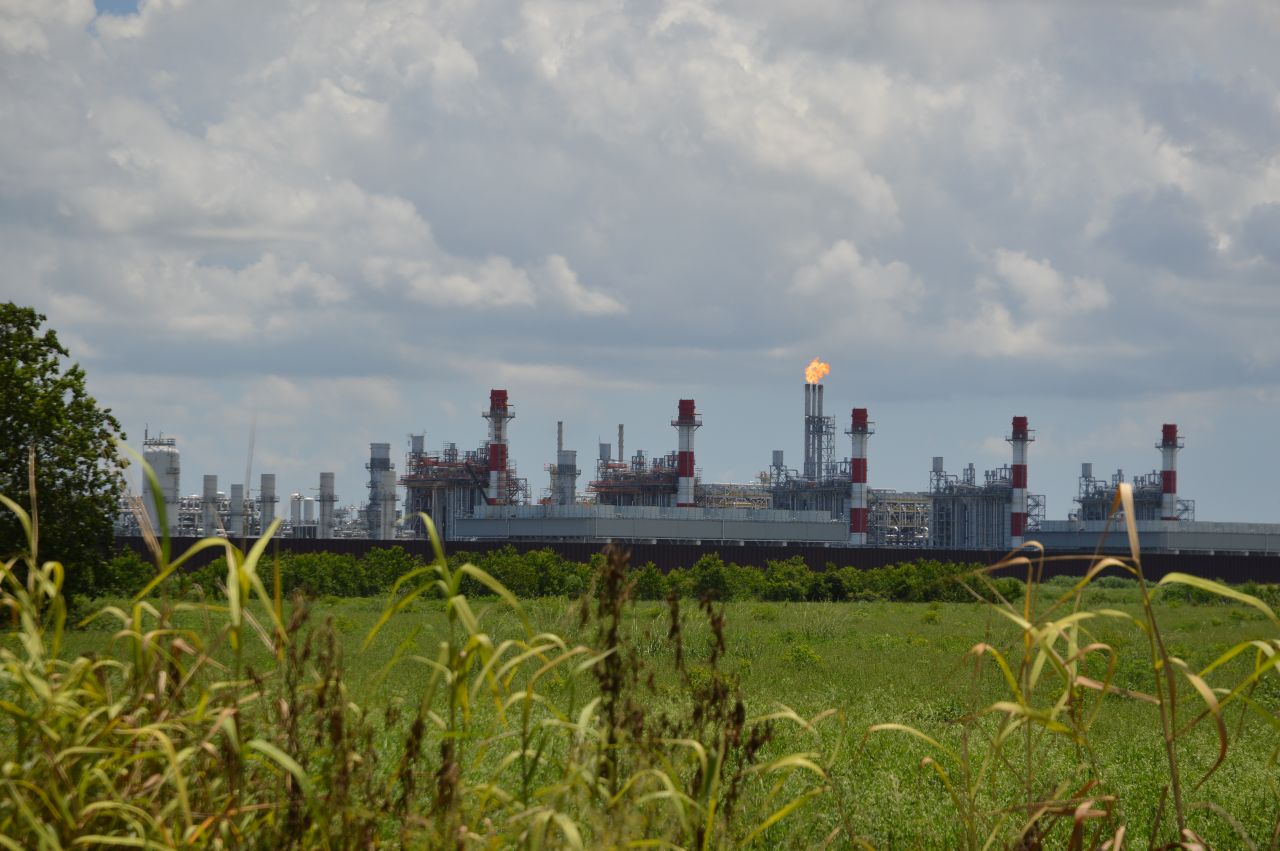Opening of new plastics plant brings glowing orange clouds and repeated pollution violations

POTTER TOWNSHIP, Pennsylvania – It was the glowing orange clouds, like a bomb blast lingering in the night sky over western Pennsylvania, that most unnerved residents of Beaver County when the Shell plastics plant started operating in November.
Because the construction of the Shell Polymers Monaca plant, northwest of Pittsburgh, had received $1.65 billion in taxpayer subsidies and had been featured on the local news, neighbors were not surprised to see a large factory rise on the banks of the Ohio River.
But they were not expecting clouds over the plant illuminated by the plant’s lights and blazing flares that at times made it look like the sun was setting on the wrong side of the sky. Nor were they anticipating foam floating down the river, or the roaring sounds like a passenger jet taking off, but never leaving.
“When I first saw the orange glow, I was driving and it looked like a really big fire, far, far away in the distance,” recalled Andie Grey, who lives nearby in Aliquippa, Pennsylvania. “I thought, 'That couldn’t be the plant.' From where I was on the road then, the plant was 17 miles away. But then as a drove closer, I realized: yes, yes … that is the plant. You could see that orange glow from 17 miles away.”

Community concerns about the strange lights and sounds from the plant, which transforms a component of fracked natural gas into tiny plastic pellets used to make soda bottles and other single-use plastic goods, turned out to be based on more than just appearances.
State records show that the Shell plant exceeded its permitted annual limits for smog-forming air pollutants within months of opening. The Pennsylvania Department of Environmental Protection’s website lists 14 violations for the facility, three since officially opening on Nov. 15. These include a violation notice on Feb. 13 for exceeding legal limits for nitrogen oxides and volatile organic compounds.
The plant has reported 34 malfunction incidents since it began ramping up operations while under construction in January 2022. These include 11 malfunctions over the last four months – some of which forced the company to release and burn chemicals in flares that illuminated the clouds.
These incidents included a malfunction of an ethane processing (“cracking”) furnace that released excess emissions of nitrogen oxide pollution on Feb. 1, 2023. There was also an “unexpected upset” of an ethane unit on Nov. 28 that resulted in excess emissions from the plant’s flares. And on Feb. 13, the plant released large plumes of black smoke and flames for hours due to another “upset” in the ethylene cracking unit.
“People have grown increasingly concerned with the disruption that the plant creates, and the continued violations of the emissions limits,” said Grey, who volunteers with a local watchdog organization called Eyes on Shell. “If the plant is going to be here and operate, it needs to do that in a legal way. We know that, right now, it is illegally polluting this community because they have already exceeded their emission limits and continue to do so. So residents here are rightly concerned and rightly frustrated.”

Despite the numerous violations and repeated malfunctions at the Shell plastics plant, the state has only fined the plant twice, according to state records. One was a $10,000 penalty while construction on the plant was underway for air pollution exceedances on Nov. 11, 2019. And the other was a $4,313 penalty on Feb. 4, 2022, for “malodorous air contaminants.”
These were tiny amounts of money compared to the record-setting $40 billion in profits that the global oil and gas company earned in 2022, in part because of higher fuel prices driven by the Russian invasion of Ukraine.
Because the state has not enforced the law, environmental groups have launched legal actions to try to protect public health. On Feb. 2, the Philadelphia-based Clean Air Council and the Washington, D.C.-based Environmental Integrity Project filed a notice of intent to sue the company for repeated violations of the plant’s permitted air pollution limits.
“Shell’s exceedances are not just numbers in a book, they are tons of pollution that can harm and even kill people,” said Joseph Minott, Clean Air Council executive director and chief counsel. “We can’t allow these pollution events to become the cost of doing business. There must be strict penalties to deter this clear violation of the laws.”

When the air pollution problems and flaring at the plant continued – including billowing flames and plumes of black smoke pouring from a smokestack – the environmental groups and “Eyes on Shell” on Feb. 17 sent a letter to the Pennsylvania Department of Environmental Protection (DEP) urging the state agency to temporarily shut the plant down until the problems can be diagnosed and fixed.
In response, James E. Miller, regional director of the DEP, wrote a letter stating that DEP’s investigation is ongoing but noting that the plant is still young and figuring out its operations. “The commissioning phase is when equipment and controls are turned on and operated for the first time,” Miller wrote. “Shell has represented to the Department that commissioning operations are not representative of normal operations.”
Shell spokesman Curtis Thomas said in a written statement: “Several factors contributed to the additional flaring during startup, all related to the complexities of commissioning brand new systems and equipment that make up oneof the largest construction projects in the country. Though flaring acts as a contingency to combust gases before they enter the atmosphere, no violation is acceptable.”
Because local residents in Beaver County do not completely trust Shell or DEP to report problems or chemical releases from the plant, Eyes on Shell and allied groups have launched a citizen-led project to perform their own monitoring of the plant with air pollution sensors and cameras.
Shell operates its own ring of 20 air monitors around the plant, sampling for regulated pollutants including benzene.
But on top of this, the Eyes on Shell group performs its own independent air monitoring around the plant, including for volatile organic compounds.
“The citizens so far have been complaining about the lights and noises the plant makes. But I am concerned about the things you can’t see,” said Dr. Clifford Lau, a retired chemistry professor who is leading the citizen air monitoring for Eyes on Shell. “They are building a chemical plant all around us. And, being a chemist, I am concerned about the hazardous air pollutants.”
Volunteers with allied groups, the Carnegie Mellon University CREATE Lab and the Breathe Project, also operate a digital video camera that is focused on the plant’s smokestacks and flares called the “Breathe Cam.” The Breathe Cam provides 24/7 visual data about flaring and pollution releases to anyone in the community who looks online.
“It’s a way of giving people as much real-time information as possible,” said Anaïs Peterson, an organizer for Earthworks who is helping with the monitoring project.

Community members are also using social media to raise alarms about malfunctions, flares, and pollution releases at the plant. For example, on March 14, an anonymous local man posted this video on Instagram showing fire and smoke pouring out of what appears to be an overheated stack at the plant. “Dude, how much more can they get away with?” the man asks.
In addition to this video and air monitoring, volunteers with the Three Rivers Waterkeeper organization hop in boats and walk along the Ohio River and dipnets into the water to see if plastic pellets – called “nurdles” – are escaping from the plant. These are called “nurdle patrols,” and there is a reason for the vigilance, in part because the toxic pill-like nodules threaten wildlife and persist indefinitely. Among other nurdle disasters, a plastics plant in Texas spilled hundreds of millions of these toxic plastic pills into Lavaca Bay on the Gulf of Mexico.
Some residents who live in the neighborhood around the Shell plant – including on a hill, overlooking the massive industrial complex – said they have mixed feelings about the facility, in part because 600 people work at the plant.
“There are pros and cons to the plant,” said a woman whose husband works at Shell and asked not to be named. “The only pros are that a lot of family and friends have steady jobs down there.”
A neighbor, Dominick Treemarchi, 71, a retired steelworker, said: “I think it’s brought in jobs. But I do worry because there is also a lot of pollution, a lot of flaring, and I believe there are a lot of nodules going into the river. And there is a lot of light and sound pollution. The trains going to the plant blows their horns all night. That’s my bedroom window right there,” he said, gesturing toward a condo overlooking the riverside plant.
The jobs at the plant have come with a heavy price from taxpayers, said David Passmore, a professor emeritus at Penn State University who studied the state economic subsidies provided to Shell for the plant.
The $1.65 billion in state tax breaks and subsidies provided by former Republican Governor Tom Corbett and state lawmakers breaks down to about $112,000 per year per job in government support to create a total of 600 jobs, according to Passmore’s calculations. This taxpayer money will keep flowing for decades. It's one of the biggest public subsidies in the state’s history, Passmore noted. And it includes the state paying a cash subsidy to a multi-billion-dollar private corporation of 5 cents for every gallon of ethane the plant uses to make plastic.

“When you focus on Beaver County, Beaver County is not getting much out of this at all,” said Passmore. “People quite regularly drive from outside Beaver County to take jobs in Beaver County. So when you look at that, there is probably not much economic activity being generated in Beaver County itself,” he said.
The Shell plant’s permits authorize the facility to release 2,303,645 tons of greenhouse gases per year, according to public records examined by Oil & Gas Watch. The plant is also permitted to release 2,049 tons of health-damaging “criteria” air pollutants annually, including 164 tons per year of microscopic soot-like particulates (which can trigger heart and asthma attacks), 329 tons per year of nitrogen oxides and 517 tons per year of volatile organic compounds (both of which contribute to smog).
And these pollution totals don’t even take into account the illegal, unpermitted pollution releases that have plagued the plant’s first four months of operations.
“I’m not going to second-guess Shell,” said Passmore. “Shell put on the green eye shades and decided they could make money from this, even though it’s a crazy, volatile plastics market with a lot of uncertainty. The state government made the decision for us that we (taxpayers) should co-invest with Shell. That’s the part I have problem with.”
The big picture is that the plant – with all of its taxpayer subsidies – is using fracked natural gas to create an end product, plastic – that is itself often a pollutant and a persistent burden on the Earth’s oceans and ecosystems.
“They are not only producing pollution, they are making a product that is itself pollution,” said Dr. Clifford Lau of the Eyes on Shell organization. “It’s a dirty train from beginning to end.”
















